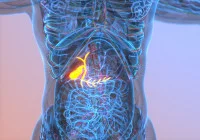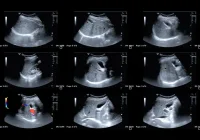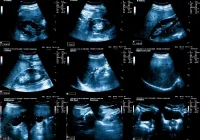Accurate preoperative distinction between hepatocellular carcinoma, intrahepatic cholangiocarcinoma and hepatic inflammatory pseudotumour remains difficult on routine imaging and serum markers, yet the consequences are significant. HCC and ICC often require surgery or systemic therapy, whereas HIPT is benign and may be managed conservatively, so misclassification can lead to unnecessary invasive procedures and added risk. A machine learning model that integrates dynamic contrast-enhanced MRI radiomics with clinical data has been developed to address this gap. In a multi-centre cohort, the combined approach reached a macro-average AUC of 0.933 and an accuracy of 84.5%, outperforming single-modality models and improving ICC identification, a frequent diagnostic challenge.
Clinical Need and Cohort
HCC accounts for most primary liver cancers worldwide, ICC incidence is rising, and HIPT, although rare, can mimic malignancy on imaging. Distinguishing among these entities before treatment planning is essential because therapeutic pathways and surgical strategies differ. Misdiagnosis can prompt biopsy or surgery with risks such as bleeding, infection and needle-track seeding. Conventional imaging and biomarkers show limited sensitivity and specificity in this setting, underscoring the need for more reliable noninvasive tools.
The analysis drew on 280 pathologically confirmed cases collected across three hospitals between 2008 and 2024: 160 HCC, 80 ICC and 40 HIPT. All patients underwent preoperative DCE-MRI within one month before surgery, without prior adjuvant therapy or biopsy. Clinical variables included age, sex, hepatitis B status, cirrhosis and tumour markers (AFP, CEA, CA19-9). Imaging features evaluated under LI-RADS v2018 included size, capsule, margins, shape, bile duct dilation, hepatic lobe atrophy, rim and peritumoural enhancement, targetoid appearance and portal vein tumour thrombus. Statistically significant group differences were observed for several features, including capsule presence, shape and hepatic lobe atrophy.
Building the Model
Lesions were segmented on T2-weighted, arterial, portal venous and delayed phase MRI. Radiomics features spanning shape, first-order statistics and multiple texture families, as well as wavelet-transformed features, were extracted with a standardised pipeline. Repeatability thresholds were enforced by retaining features with intraclass correlation coefficients above 0.9. Imaging data were resampled and intensity-normalised, and assessments for batch effects across acquisition periods did not show significant differences, so ComBat harmonisation was not applied.
Feature sets were built from radiomics alone, clinical variables alone, and a fusion of radiomics with clinical data. Six algorithms were explored, including logistic regression, random forest, support vector machine, decision tree, k-nearest neighbours and extreme gradient boosting. To address class imbalance across HCC, ICC and HIPT, class weights of 1:2:4 were used. Data were split 70:30 into training and test cohorts without stratification, with five-fold cross-validation and grid search guiding hyperparameter selection. Model selection and evaluation used AUC, accuracy, recall, precision, F1-score and Kappa on the held-out test set, with bootstrap validation for AUC distributions and statistical comparisons between models.
Feature importance analyses highlighted clinically familiar signals. Rim enhancement and arterial-phase texture metrics were prominent for HCC classification. Hepatic lobe atrophy and rim enhancement ranked among the strongest contributors for ICC. For HIPT, hepatic lobe atrophy and arterial-phase texture features were influential, alongside shape and first-order statistics. These patterns align with established imaging descriptors while leveraging high-dimensional texture information captured by radiomics.
Performance and Diagnostic Signals
Across radiomics-only models, logistic regression using arterial-phase radiomics achieved a macro-average AUC of 0.856 and 72.6% accuracy on the test set, correctly classifying 61 of 84 cases. Clinical-only modelling, best with random forest, reached a macro-average AUC of 0.795 and 66.7% accuracy, with 56 correct classifications. The fusion model that combined arterial-phase radiomics with clinical features delivered the highest performance, with a macro-average AUC of 0.933, accuracy of 84.5%, recall of 84.1% and precision of 81.3%, accurately classifying 71 cases, including 43 HCC, 17 ICC and 11 HIPT.
Performance gains were statistically significant. Macro-average AUCs differed between the fusion model and both radiomics-only and clinical-only models, with p values of 0.001 and 0.002, respectively. The clinical-only and radiomics-only models also differed, with a p value of 0.043. Per-class analyses showed significant improvements for HCC, ICC and HIPT when comparing fusion with radiomics-only, and fusion with clinical-only. The radiomics-only and clinical-only models did not differ significantly for HCC and ICC, though a difference emerged for HIPT. The fusion approach therefore consolidates complementary information to enhance three-way differentiation, with particular strength in ICC identification.
Must Read: Improving Liver MRI Quality and Reducing Scan Time with AI
Model interpretability echoed clinically relevant cues. Rim enhancement supported separation of HCC from ICC and HIPT, while hepatic lobe atrophy contributed to distinguishing ICC and HIPT from HCC. These predictors fit within LI-RADS-based assessment and routine radiology review, offering a bridge between high-dimensional radiomics and observable imaging traits. Given the differing surgical planning requirements for ICC compared with HCC, better preoperative identification can inform nodal assessment and resection strategy. For HIPT, improved recognition may help avoid unnecessary invasive procedures and the related risks.
An MRI radiomics model fused with clinical data achieved strong preoperative three-class discrimination among HCC, ICC and HIPT, with a macro-average AUC of 0.933 and 84.5% accuracy, outperforming single-source models and enhancing ICC detection. The approach remains noninvasive and grounded in imaging features familiar to radiologists, which may ease clinical uptake. Limitations include a relatively small HIPT sample, single-country data, exclusion of combined HCC-ICC and reliance on manual segmentation. Broader multicentre validation, automated segmentation and integration of additional modalities could further test robustness and support implementation.
Source: Insights into Imaging
Image Credit: iStock









